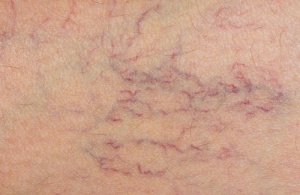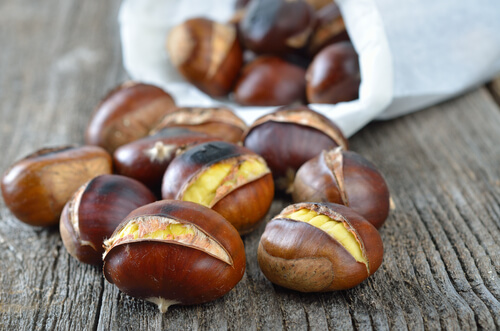Indian Horse-Chestnuts: A Possible Ally Against Varicose Veins


Written and verified by the doctor Gilberto Adaulfo Sánchez Abreu
Indian horse-chestnuts may help fight the effects of varicose veins and treat restless leg syndrome. Chronic venous insufficiency affects a large part of the population. It’s also annoying, makes our daily lives difficult, and has a very anti-aesthetic component.
Thus, varicose veins are one of the most uncomfortable conditions with the most complex of treatments.
Fortunately, there are several existing studies that indicate that Indian horse-chestnuts may be an effective vasoconstriction regulator. Thus, this is why the components of its seeds are used to help treat all of these associated illnesses.
They achieve good results in patients that have been under little observation and medical supervision. Here, we’ll tell you more about it.
Read more here: 8 Rules to Follow If You Want to Cure Varicose Veins
What are Indian horse-chestnuts?
Indian horse-chestnuts are native to Asia, but that can be found all over the world. In fact, we’re used to seeing it majestically in our parks. Here are some of its medicinal properties:
- Leaves: Are very effective at helping treat eczema, menstrual pain, soft tissue swelling due to fractures or sprains, and even joint pain.
- The bark is frequently used to help treat malaria and dysentery, and it’s even being studied to see what effects it may have on people affected by lupus and skin ulcers.
- Seeds: Aescin, its main component, may help reduce inflammation and pain in the legs. It promotes circulation and reduce water retention.
How do Indian horse-chestnuts work?
Indian horse-chestnuts contain a component in their seeds, aescin, which may favor normal blood circulation. This also reduces the risk of edemas by promoting liquid loss through the urine.
Also, it may be appropriate when we feel this well-known swelling in the veins in the legs, heaviness at the height of the knees, or inevitable cramps that cause so much pain.
Indian horse-chestnuts help strengthen our capillary resistance to help treat edemas and reduce inflammation. They’re also very useful when we have those typical spider veins on our legs, those frightening ulcers, or hemorrhoids.
How to consume Indian horse-chestnuts

You can find Indian horse-chestnuts in natural stores or herb stores in capsules. This is a standardized extract from these seeds that is frequently commercialized in the form of pills, as well as in creams and even ointments.
The most appropriate dosage is 400 mg a day, which would equal 2 capsules a day. Take then before breakfast and after dinner.
Is there any disadvantage to consuming them?
We should warn you of something important: never eat the leaves, flowers, or bark in raw form, as they are poisonous.
It’s best to consume the medicinal preparations made in the laboratories, where they isolate all their components and synthesize those that aren’t beneficial.
You should also limit your consumption to Indian horse-chestnut capsules if you are:
- Pregnant, diabetic, or are a patient with liver problems, as they have a component that could not be beneficial for these populations.
This article may interest you: 10 Benefits of Chestnuts in Your Diet
In conclusion, Indian horse-chesnuts may be a beneficial partner for circulation and is a natural treasure that may help a lot of people.
All cited sources were thoroughly reviewed by our team to ensure their quality, reliability, currency, and validity. The bibliography of this article was considered reliable and of academic or scientific accuracy.
-
- Suter, A., Bommer, S., & Rechner, J. (2006). Treatment of patients with venous insufficiency with fresh plant horse chestnut seed extract: A review of 5 clinical studies. Advances in Therapy. https://doi.org/10.1007/BF02850359
- Sirtori, C. R. (2001). Aescin: Pharmacology, pharmacokinetics and therapeutic profile. Pharmacological Research. https://doi.org/10.1006/phrs.2001.0847
- Asgari Rad, H., Azadbakht, M., Sharifpour, A., & Mazloom, F. (2007). Preparation and evaluation of horse chestnut seed extract gel and its effect on varicose disease symptoms. Journal of Medicinal Plants.
- Pittler Max, H., & Ernst, E. (2006). Horse chestnut seed extract for chronic venous insufficiency. Cochrane Database of Systematic Reviews. https://doi.org/10.1002/14651858.CD003230.pub3
- WebMD. HORSE CHESTNUT. https://www.webmd.com/vitamins/ai/ingredientmono-1055/horse-chestnut
- Mª Teresa Sánchez de Membiela. Fitoterapia para el tratamiento de la insuficiencia venosa
crónica. El castaño de indias. https://www.google.com/url?sa=t&rct=j&q=&esrc=s&source=web&cd=5&cad=rja&uact=8&ved=2ahUKEwjZ5eOsqNDlAhUcxMQBHWwGAqUQFjAEegQIBRAC&url=https%3A%2F%2Fwww.fitoterapia.net%2Fphp%2Fdescargar_documento.php%3Fid%3D4532%26doc_r%3Dsn%26num_volumen%3D22%26secc_volumen%3D5959&usg=AOvVaw0doBJhMKkZKvXrhRif7FkI
Revista Brasileira de Farmacognosia. Volume 25, Issue 5, September–October 2015, Pages 533-541. Horse chestnut – efficacy and safety in chronic venous insufficiency: an overview. https://www.sciencedirect.com/science/article/pii/S0102695X15001003
This text is provided for informational purposes only and does not replace consultation with a professional. If in doubt, consult your specialist.








